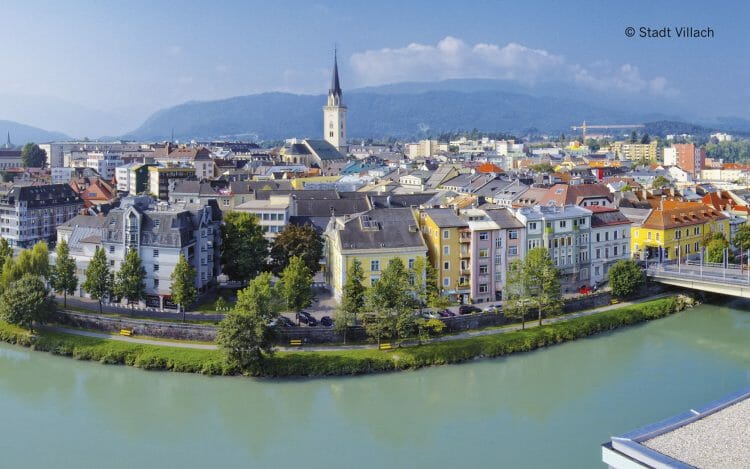Villach not only provides a wonderful portion of “dolce vita”, but also guarantees a relaxed trip around town, enjoyable mountains views and a lake experience all in one. The second-largest town in Carinthia with over 60,000 inhabitants charms its visitors with a leisurely, southern Mediterranean way of life – perfect for gourmets, art enthusiasts, shopping fans and leisure seekers.
There are also several festivals throughout the year:
The carnival in Villach (which starts on November 11 and ends on March 4)
The arts and crafts festival (with self made goods)
Villacher Fasching (Carnival parades)
The streets-art festival (displays performances of artists and singers)
Perchtenlauf (parade of Krampuses) – in early December
Villacher Kirchtag (a festival spanning a whole week in summer and ends on August’s first Saturday.)
Performances on a floating stage on the Drau River
- At a glance
- Airports
- Ski Resorts
- Lakes
- History
Fast Facts about Villach
- Airports : Klagenfurt (30 mins by car)
- Ski Resorts : Nassfeld (35 mins by car)
- Lakes : Faaker See (15 mins by car)
- Nearby Towns/Cities : Klagenfurt (35 mins by car)
- Other : Cinema, Shopping, Restaurants, Museums, Art Galleries etc
'The' ski resort in Carinthia - here you will find everything a winter sports enthusiast´s heart desires... and much more. How about, for example, stopping for refreshment in Italy or the sun as your companion on the varying pistes all day? Sporty skiers and families alike enjoy unique days of skiing on 110 kilometres of pistes with 30 mountain railways & lifts at the ski resort Nassfeld – and all that with almost absolute snow-reliability! Enjoy your days skiing at Nassfeld with a plus on hours of sunshine and a unique mountain panorama!
Visitors of the border triangle (Dreiländereck) will have snow, 62 snow guns, southern sun, 17 km of perfectly groomed slopes (blue 5.7 km, 7.6 km red and 3.7 km black) in all difficulty levels and 4 cabins to the leisurely break.
Furthermore, there is a children's area in the valley station.
Crystal clear and pure water – it’s the luxury to be able to bath in water with up to 28°C and drinking water quality. This makes the Faaker See to one of the warmest bathing lakes in Austria. There is also an island in the Faaker See. With wood, Tennis courts, a bath house, a spacious lawn and Austrias only Hotel which is situated on an island. The chiselled mountains and lawns like fragrant carpets make this a special place. The reed beds also have amazing flora and fauna.
Family fun can be had with the best leisure activities, thrilling playgrounds and wonderful lidos. Numerous walking, hiking, and bike trails offer special ways to discover the scenic landscape. At the lake you can try windsurfing, sailing and do boat cruises.
Ossiacher See
Lake Ossiach has that certain something: dreamy retreat possibilities, atmospheric unspoiled banks, dreamlike mountain scenery, marvellous sunsets as well as best water quality. The Ossiacher See in the northeast of Villach offers diverse activities and landscape for lake adventurers and summer visitors. There are peace and culture on the one hand and sports and events on the other. Explore the lake with all kind of water sports while the mountains are within your reach. The Gerlitzen Alpe which rises on the northern shore of Lake Ossiach is one of the most beautiful spots for parasailing in Austria.
“Curtain up” - there are a lot of different cultural events around Lake Ossiach. Especially the international music festival “Carinthischer Sommer” brings a diverse Audience to Lake Ossiach.
While enjoying nature and landscape at the easy-to-handle slow trail through the Bleistätter Moor, you can calm down and prepare for further leisure activities.
Plenty of restaurants and shops are located arounds the shores of the lake.
When about 740 Prince Boruth enlisted the aid of Duke Odilo of Bavaria against the invading Avars, he had to accept Bavarian overlordship. An 878 deed of donation, issued by the Carolingian ruler Carloman of Bavaria, mentioned a bridge (ad pontem Uillach) near the royal court of Treffen, in what is today Villach. In 979 Emperor Otto II enfeoffed Bishop Albuin of Brixen with the Villach manor. After his death, King Henry II in 1007 ceded the settlement to the newly established Bishopric of Bamberg. The bishops also held the adjacent estates along the strategically important route to Italy up to Pontafel, which they retained until 1759 while the surrounding Carinthian ducal lands passed to the Austrian House of Habsburg in 1335.
Villach received market rights in 1060, though it was not mentioned as a town in records until about 1240. The parish church dedicated to St. Jacob was first documented in 1136. Emperor Frederick II conferred the citizens the right to hold an annual fair on the feast of 25 July (Jakobitag) in 1222. The 1348 Friuli earthquake devastated large parts of the town, another devastating earthquake occurred in 1690. There were also several fires in Villach, which destroyed many buildings. The first documented mayor took office in the 16th century.
From 1526 onwards, many citizens turned Protestant and the Villach parish became a centre of the new faith within the Carinthian estates, which entailed harsh Counter-Reformation measures by the ecclesiastical rulers. From about 1600, numerous residents were forced to leave the town, precipitating an economic decline. In 1759 the Habsburg empress Maria Theresa formally purchased the Bamberg territories in Carinthia for a price of one million guldens. Villach was incorporated into the "hereditary lands" of the Habsburg Monarchy and became the administrative seat of a Carinthian district.
During the Napoleonic Wars, the city was occupied by French troops and became part of the short-lived Illyrian Provinces from 1809, until it was re-conquered by the forces of the Austrian Empire in 1813 and incorporated into the Austrian Kingdom of Illyria by 1816. The city's economy was decisively promoted by a western branch of the Southern Railway line, which finally reached Villach in 1864, providing growth and expansion. By 1880, the town had a population of 6,104. In World War I, Villach near the Italian front was the seat of the 10th Army command of the Austro-Hungarian Army.
The town obtained statutory city status during the interwar period on 1 January 1932. After the Austrian to Nazi Germany in 1938, the mayor of Villach was Oskar Kraus, an enthusiastic Nazi. On 9 November 1938 Villach was a site of the nationwide pogroms with violent attacks on the Jewish population. A memorial for the 1919 border conflict that led to the Carinthian Plebiscite caused controversy when it was inaugurated in 2002, as Kraus, who had not been especially prominent in the conflict, was the only person named.
During World War II, allied forces bombed Villach 37 times. About 42,500 bombs killed 300 people and damaged 85% of the buildings. Nevertheless, the city quickly recovered. Today, Villach is a bustling city with commerce and recreation, yet it retains its historic background.
- Road Map
- Road Map


